How to change the file's attributes using the Attrib command
In Windows, file attributes are settings associated with files on a computer that grant or deny certain rights to users or operating systems associated with accessing that file. The following article will show you how to change the properties of any file using attrib command in Command Prompt.
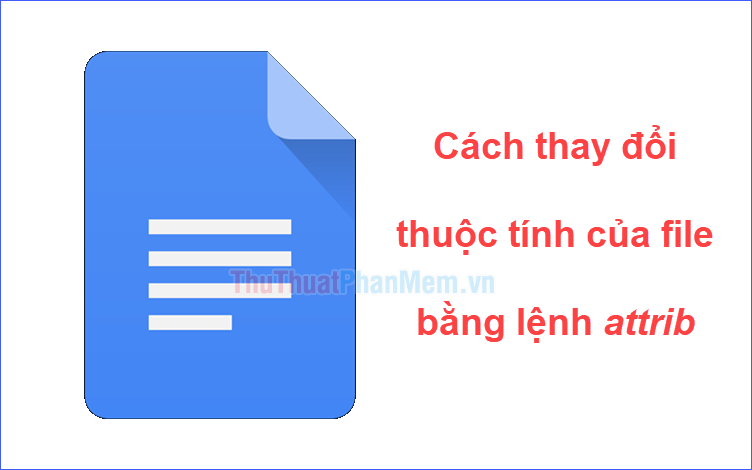
Types of file attributes
First, we need to know what kind of attributes a computer file can carry. With Windows operating systems, there are four traditional types of file attributes:
- Read-only : Can read, but cannot change or delete;
- Hidden : By default will not be displayed in the list of files located in the directory;
- Archive : Used to selectively back up or copy files;
- System : Mark important system files, necessary to the computer operating properly (by default will be hidden even if you unhide the files Hidden ).
In the new versions of Windows, many types of file attributes have been updated, such as Encrypted , Not Content-Indexed , Offline , etc. However, for general users, most of those attribute types are never used. use in this article I will not mention.
Instructions to change the properties of the file with the attrib command
Each type of file attribute has a unique symbol. Before using the command to change file attributes, you need to know the symbol that corresponds to each attribute type:
- Read-only with symbol R;
- Hidden with symbol H;
- Archive with the symbol A;
- System has the symbol S.
Then you proceed to change the properties of the file according to the following steps:
Step 1: Open Command Prompt (can use the Search feature , search by keyword "cmd", right-click on the Command Prompt result and select Run as administrator ).
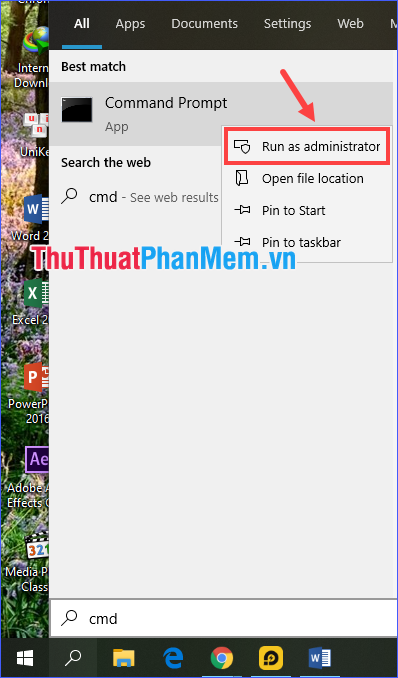
Step 2: Use attrib command to change the properties of the file.
* To add an additional attribute to the file, enter the following command and press Enter :
attrib +Inside:
- Attribute symbol : A symbol corresponding to the attribute you want to add to the file;
- Path of the file : The full path to that file.
For example, add the Hidden attribute as follows:
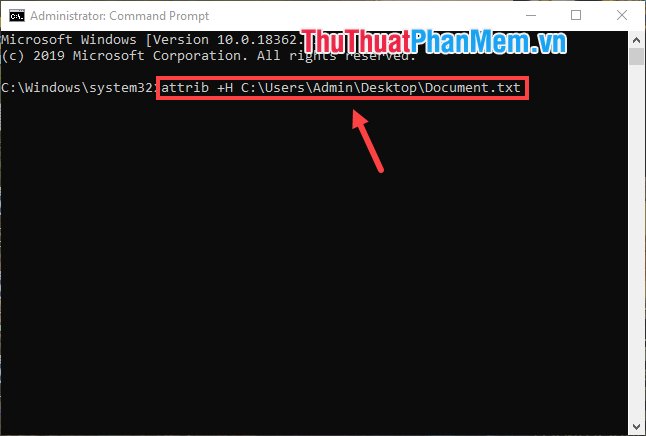
* To cancel an existing property of the file, enter the following command and press Enter :
attrib -For example, cancel the Hidden property :
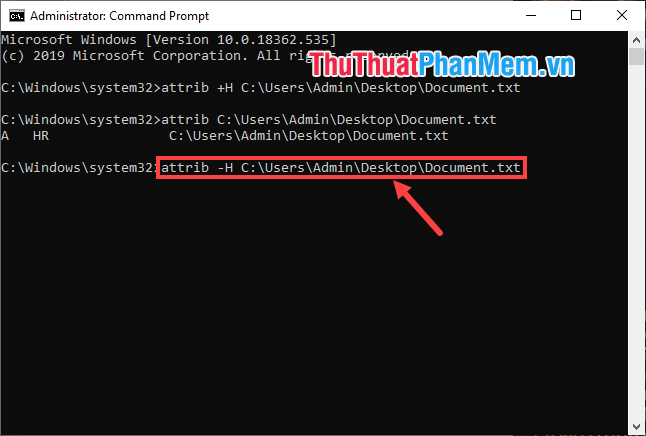
* The attrib command can also change multiple properties at once for a file.
For example, cancel both Hidden and Read-only properties simultaneously :

* You can also use the attrib command to see what properties a file has:
attribThe symbols in the resulting line indicate the properties of the file.
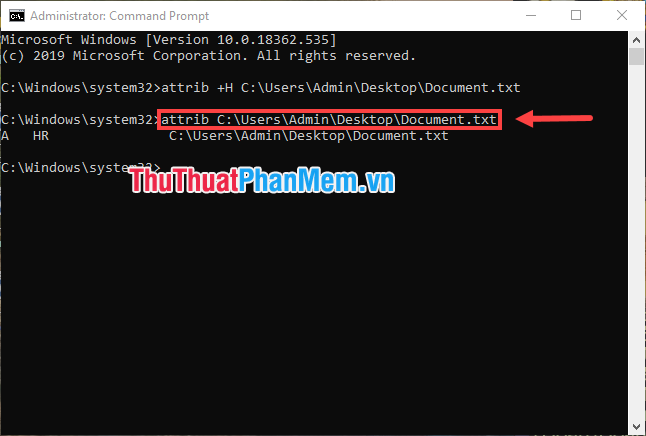
Through the article above, I showed you how to change the properties of the file with the attrib command . Hope that the information just shared above will be helpful for you!
You should read it
May be interested
- How to Change File Dates
 when a file is created on a computer, it is automatically given a set of attributes. these attributes include the date, size and file format. however, file dates may occasionally need to be changed. windows 8, windows 10 and mac are the...
when a file is created on a computer, it is automatically given a set of attributes. these attributes include the date, size and file format. however, file dates may occasionally need to be changed. windows 8, windows 10 and mac are the... - Change all file extensions in a Folder with the CMD command
 instead of using supporting software, or changing the tail with f2 key, you just need to use the simple command in cmd to be able to change a series of files in the same folder.
instead of using supporting software, or changing the tail with f2 key, you just need to use the simple command in cmd to be able to change a series of files in the same folder. - Style HTML with CSS
 css is added to html elements in three ways: inline, internal and external.
css is added to html elements in three ways: inline, internal and external. - The Cat command in Linux
 the cat command (short for 'concatenate') is one of the most frequently used commands in operating systems like linux / unix. the cat command allows users to create one or more files, view file contents, join files, and redirect output in a terminal or file.
the cat command (short for 'concatenate') is one of the most frequently used commands in operating systems like linux / unix. the cat command allows users to create one or more files, view file contents, join files, and redirect output in a terminal or file. - How to Change Directory in Command Prompt
 this article shows you how to change folders in the command prompt program on a windows computer. to change commands in command prompt, you must use an administrator account.
this article shows you how to change folders in the command prompt program on a windows computer. to change commands in command prompt, you must use an administrator account. - The cipher command in Windows
 the cipher command displays or changes the encryption of folders and files on ntfs volumes. if used without parameters, the cipher command displays the encryption status of the current directory and any files that contain it.
the cipher command displays or changes the encryption of folders and files on ntfs volumes. if used without parameters, the cipher command displays the encryption status of the current directory and any files that contain it. - Tricks to change Command Prompt background color on Windows
 if you want to change the background color of command prompt to make it easier to see, you can. in the article below, network administrator will guide you through the steps to change the color of command prompt on windows.
if you want to change the background color of command prompt to make it easier to see, you can. in the article below, network administrator will guide you through the steps to change the color of command prompt on windows. - How to HIDE / SHOW files and folders by cmd command on Win 10/8/7
 instructions on how to hide / show files or folders by command in command prompt. the trick to hide files with the cmd command on windows operating systems is extremely fast
instructions on how to hide / show files or folders by command in command prompt. the trick to hide files with the cmd command on windows operating systems is extremely fast - How to change the folder in Command Prompt on Windows 10
 one of the first things you need to learn when you become more familiar with the command prompt on windows 10 is how to change the folders in the file system of the operating system. the following article will guide you to implement them.
one of the first things you need to learn when you become more familiar with the command prompt on windows 10 is how to change the folders in the file system of the operating system. the following article will guide you to implement them. - The dd command in Linux, How to use the dd command
 dd is a command line utility for unix-like and unix operating systems, with the main purpose of converting and copying files.
dd is a command line utility for unix-like and unix operating systems, with the main purpose of converting and copying files.










 How to Play Wifi on Windows 8, share Wifi on Windows 8 without software
How to Play Wifi on Windows 8, share Wifi on Windows 8 without software What is Windows Explorer? How to open Windows Explorer
What is Windows Explorer? How to open Windows Explorer What is thread? Differences between Process and Thread
What is thread? Differences between Process and Thread What is a temporary file? Does deleting the Temp file affect the computer?
What is a temporary file? Does deleting the Temp file affect the computer? What is the OS (Operating System)? Overview of the operating system (OS)
What is the OS (Operating System)? Overview of the operating system (OS) What is a DMG file? How to open DMG files on Windows
What is a DMG file? How to open DMG files on Windows